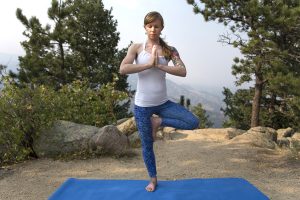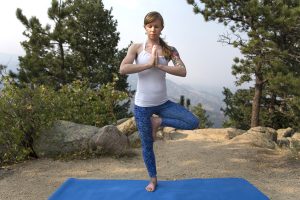 With the Fall season in full effect, it is the perfect time for a grounding pose to honor one of the very things that makes Fall so special, the trees. Vrksasana, also known as Tree Pose, is a great way to find balance and stability during this season of Vata dosha. This season is known to increase issues such as a restless mind, anxiety, worry and fear, all of which can be calmed with regular practice of this posture. Vrksasana teaches us a strong sense of rootedness, all while finding the softness and ease that is equally as important for standing comfortably in this powerful asana.
With the Fall season in full effect, it is the perfect time for a grounding pose to honor one of the very things that makes Fall so special, the trees. Vrksasana, also known as Tree Pose, is a great way to find balance and stability during this season of Vata dosha. This season is known to increase issues such as a restless mind, anxiety, worry and fear, all of which can be calmed with regular practice of this posture. Vrksasana teaches us a strong sense of rootedness, all while finding the softness and ease that is equally as important for standing comfortably in this powerful asana.
Vrksasana is well known for its ability to stabilize the Vayu or wind element in the body, and is especially beneficial for Apana Vayu the downward moving wind that governs elimination and menstruation. It promotes Prithvi, the Earth element, by strengthening the lower legs and providing a sense of sturdiness throughout. In order to find ease in this pose, one must learn to quiet the mind and focus the attention. Therefore this is an essential posture during times of an overstimulated nervous system and high Vata.
Although best for Vata disorders, this pose can also be made useful for Kapha when the arms are brought overhead, allowing the chest to open and the gaze to move upward. Since core strength is always needed for any balancing posture this pose is also suitable for Pitta dosha and is even better if the half lotus version (see picture below) is performed, as this variation applies pressure on two of the vital naval marma points (known as Nabhi Marmani) which regulate the digestive fire and remove obstruction from the solar plexus region.
Vrksasana
- Doshic Qualities: Vata ↓,Pitta ↓, Kapha ↓(Best for Vata, but beneficial for Pitta and Kapha especially with the proper variation)
- Best Season for Practice: Most beneficial in Fall and Winter; suitable all year round
- Elemental Component: Reduces Air and Space; nourishes and strengthens Earth, Water and Fire
- Main Areas of Strengthening in the Body: Ankles, legs, lower back and spine; creates space in the hips
- Main Organs and Systems: Colon, small intestine (in the half lotus version), lungs (with arms up and open)
Health Benefits of Vrksasana
- Stabilizes Vata and the five winds of the body
- Increases focus and concentration
- Quiets a restless mind
- Teaches balance and poise
- Regulates digestion (especially in the half lotus version)
- Removes constipation (especially in the half lotus version)
- Strengthens the ankles, legs and spine
- Opens the hips
- Best for Vata, but can be beneficial for all three doshas
Contraindications
- None (although modifications should be used when needed)
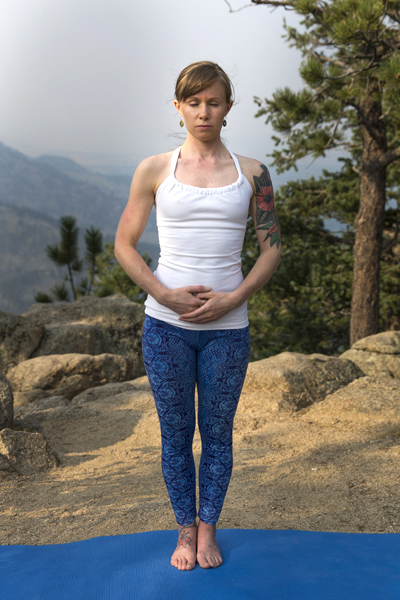
Tadasana
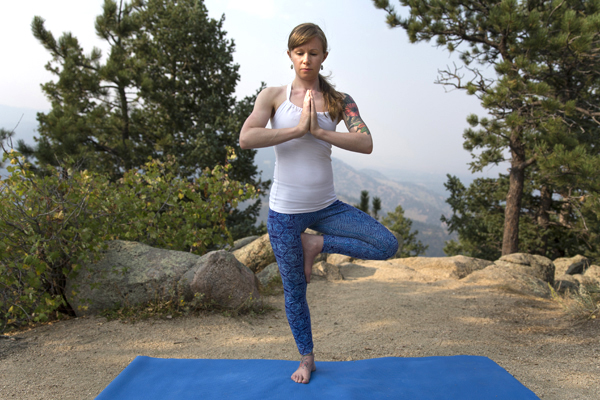
Vrksasana with the foot on the inner thigh and hands in prayer position
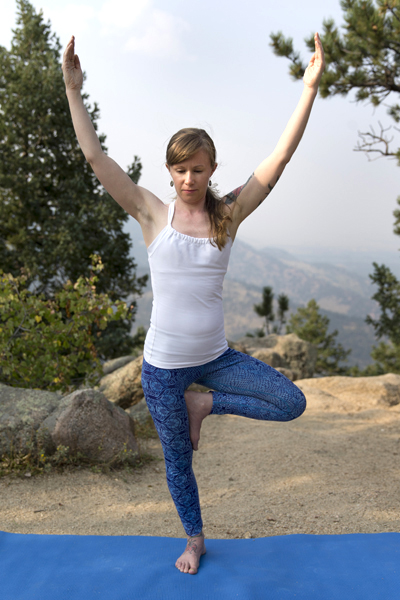
Vrksasana with the foot on the inner thigh and arms overhead
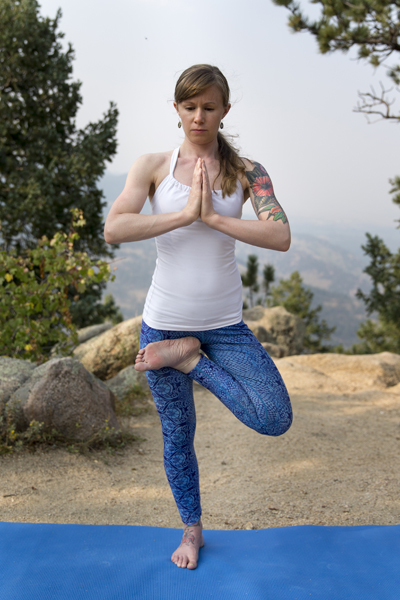
Vrksasana variation with the foot in half lotus and hands in prayer position
Step-by-Step Instructions for Vrksasana
- Stand in Tadasana or “mountain pose”. Close the eyes, quiet the mind and bring the focus onto the breath. Take note of the rootedness through all areas of the feet.
- Once the mind is quiet and steady, begin to lift the right foot, placing the weight on the left.
- Bring the right foot up to the inner left thigh, as high as it will go.
- If you are new to this posture, you may need to modify, by placing the right foot onto the inner left lower leg (directly above the ankle). Just make sure to avoid the knee joint, as this will cause instability and can compromise the knee. If this modifications is still too difficult for you in the beginning, then it may be best to practice near a wall until a stronger sense of balance can be found.
- If you prefer a more challenging version of Vrksasana (see picture above), instead of placing the foot on the inner thigh, you will place the right foot in a standing half lotus position. This may take some time to get used to, so if this is too difficult it is recommended to practice in the original variation until the hip has opened enough to comfortably stand in half lotus.
- No matter the variation you choose, it is often recommended to find a focal point to steady the gaze and focus the attention. This will help you to stay in the posture longer and with more ease.
- Once you have a steady and solid foundation in the pose, place the palms together at heart’s center in a prayer position.
- Stay here for at least five slow and steady breaths before moving on. If you have a strong Vata imbalance it is not recommended to move the hands from here, as this position provides the most sense of stability.
- If appropriate, begin to bring the arms up and overhead, allowing openness and space in the chest. The gaze should be down for Vata, straight ahead for Pitta types, and upwards for Kapha (this may take some practice). Stay here for another 5-10 deep breaths.
- Once you are ready, slowly begin to move out of the posture by bringing the arms down from overhead and back into prayer position. Stay here for one breath.
- From here, slowly release the right leg bringing the foot to the ground as you come back into Tadasana (mountain pose).
- Take a breath in Tadasana and repeat on the left side making sure to stay in each variation for the equal amount of time as the right.
**Looking for even more of a challenge?? Discover the half bound lotus variation of this posture (see picture #3 below)!


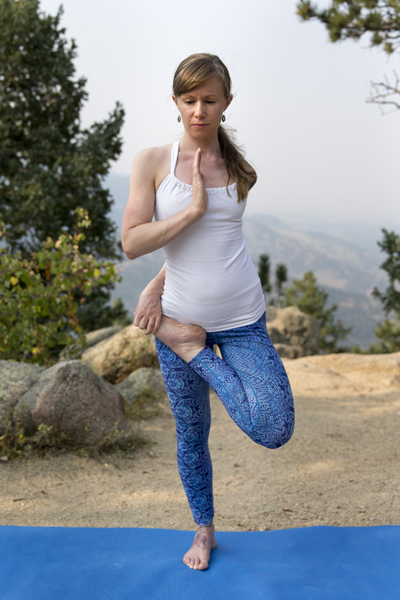
Click here to see our full apothecary menu.

